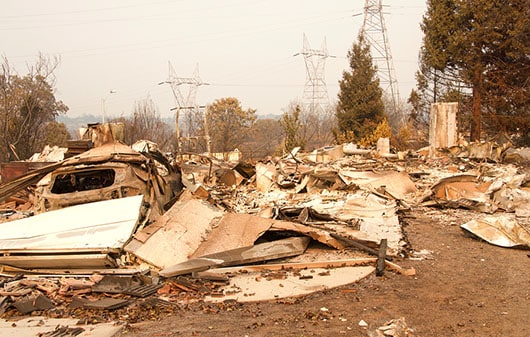A Detailed Guide to Understanding California Wildfire Damage

Worsening California Wildfire Damage Is Costing Everyone
California wildfire damage has become a major concern for residents, property owners, businesses, and public agencies, causing enormous destruction and financial loss. Here’s a quick snapshot of the damage:
- Acres Burned: Increased from an annual average of 337,000 acres (1979-1988) to 708,000 acres (2009-2018).
- Structures Destroyed: More than 60,000 structures were destroyed, with the Camp Fire of 2018 alone destroying over 18,800 structures.
- Financial Losses: Over $50 billion in insured economic losses between 2015 and 2020.
Wildfires in California have been worsening over the years, impacting both rural and urban areas. The financial toll is substantial, the environmental damage profound, and the loss of life tragic. The increased frequency and severity of these fires highlight the urgent need for effective wildfire prevention strategies.
Understanding the extent of the California wildfire damage helps underscore the importance of taking preventative measures. Installing systems like the Frontline Wildfire Defense exterior sprinkler can make a significant difference. Prescribed burns and defensible space inspections are other vital tools in reducing wildfire risk.
It’s clear that while wildfires are a natural part of California’s ecosystem, human management and climate change have amplified their intensity. Immediate action and continued focus on prevention and response are essential for protecting our communities and environment and mitigating California wildfire damage.

The Extent of California Wildfire Damage
California wildfires are becoming more severe every year. Understanding the extent of the damage helps us grasp the urgency of prevention and response measures. Let’s dive into the key areas of impact: acreage burned, structures destroyed, financial losses, and human casualties.
Acreage Burned
Historically, the severity of a wildfire was measured by the number of acres burned. While this metric is still significant, it doesn’t fully capture the human and financial toll.
According to a joint study by The Nature Conservancy and emLab UC Santa Barbara, the annual rate of acres burned in California has been increasing at an alarming rate. From 2009 to 2018, an average of 708,000 acres burned annually, compared to 337,000 acres from 1979 to 1988. This shows a doubling in the rate of acreage burned over the past few decades.
In the Wildland Urban Interface (WUI) areas, where houses and wildland vegetation coexist, the average area burned also increased. From 2009 to 2018, an average of 32,000 acres of WUI areas burned annually, compared to 22,000 acres from 1979 to 1988. This indicates that wildfires are becoming more threatening to populated areas.
Structures Destroyed
Structures destroyed by wildfires often result in the most significant financial losses. California is particularly vulnerable, with over 2 million properties at high risk of wildfire damage, according to Verisk Wildfire Risk Analysis.
California has experienced some of the most destructive wildfires in U.S. history. The Camp Fire of 2018 is the most destructive, destroying more than 18,800 structures in Butte County alone. In total, California has seen nearly 60,000 structures destroyed by wildfires, accounting for more than half of all structure losses in the United States.

Financial Losses
The financial toll of wildfires is staggering. Between 2017 and 2021, the average annual economic loss due to wildfires in California was estimated at over $117.4 billion. This includes labor market disruptions, property damage, and loss of life.
State fiscal losses alone amount to approximately $5 billion annually. These losses are due to reduced tax revenues and increased wildfire response costs. The Camp Fire alone caused an estimated $16.5 billion in damages, highlighting the immense financial impact of these disasters.
Human Casualties
Wildfires also have a tragic human cost. Civilian deaths and firefighter fatalities are stark reminders of the dangers these fires pose. The Camp Fire resulted in 85 civilian deaths, making it the deadliest wildfire in California’s history. Firefighters face significant risks, with numerous yearly fatalities as they battle these blazes.
In 2020, wildfire-driven poor air quality likely caused 1,200 to 3,000 excess deaths among people aged 65 or older. This highlights the broader health impacts of wildfires beyond immediate fatalities.
Understanding the extent of California wildfire damage underscores the need for robust prevention and response strategies.
Section 5141.1 of the State of California General Industry Safety Order is a regulation protecting workers from exposure to wildfire smoke by reducing the amount of allowable particulate matter in a work area (less than PM2.5). Key provisions of the Order include rules around exposure control, protection methods, monitoring, and communication.
California Wildfire Damage Economic and Environmental Impact
Economic Costs
Wildfires in California come with a hefty price tag. From 2017 to 2021, the average annual economic loss was $117.4 billion. This figure includes labor market disruptions, property damage, and loss of life.
- Labor Market Disruptions: Wildfires disrupt local economies by displacing workers and damaging businesses. The ripple effects can lead to long-term economic instability in affected communities.
- Property Damage: The destruction of homes, commercial properties, and infrastructure adds up quickly. For instance, the 2018 Camp Fire caused over $3.52 billion in property losses in Butte County.
After a wildfire, property owners can hire an experienced and trusted environmental consultant to conduct testing of residual soot, char, and ash. Testing results determine the chemical constituents that may have been left on the property.
Fiscal Impact
The fiscal impact on California’s state budget is also significant. Over the same period (2017-2021), the state faced an average annual fiscal loss of $5 billion. This loss is due to reduced tax revenues and increased wildfire response costs.
- Reduced Tax Revenues: When properties are destroyed, tax revenues plummet. Businesses close, and homeowners are displaced, leading to decreased income and property taxes collected by the state.
- Increased Response Costs: Fighting wildfires is expensive. In 2020, fire suppression costs surpassed the billion-dollar mark for the first time, totaling $691 million. These costs include not only firefighting but also recovery and rebuilding efforts.
Environmental Damage
Wildfires significantly impact the environment, contributing to greenhouse gas (GHG) emissions and climate change.
- GHG Emissions: During a typical wildfire season, California’s wildfires release about 1.2 billion metric tons of GHGs. This emission negates much of the state’s efforts to cut emissions through other means.
- Climate Impact: The GHGs released during wildfires add to global warming. For example, in 2020, wildfires emitted nearly 112 million metric tons of carbon and 1.2 million tons of fine particulate matter (PM 2.5). This is 120 times more fine particulate matter than all the vehicles in California produced that year.
What We Can Do About California Wildfire Damage
The economic and environmental impacts of California’s wildfires are profound. The enormous financial losses, both economic and fiscal, coupled with severe environmental damage, stress the importance of effective wildfire prevention and response strategies.
Next, we’ll explore the future outlook and prevention strategies to mitigate these devastating impacts.
Future Outlook and Prevention Strategies for California Wildfires
California Climate Conditions
California’s climate conditions are becoming increasingly favorable for wildfires. Worsening conditions such as prolonged droughts and higher temperatures create prime wildfire conditions. These factors, combined with the state’s natural vegetation, set the stage for more frequent and intense wildfires.
According to the National Significant Wildland Fire Potential Outlook, Northern California is at higher risk due to an abundance of dead branches left by heavy snowfall. Southern California also remains vulnerable due to dry fuels and offshore winds.
Wildfire Prevention Measures
To combat the escalating threat of wildfires, a variety of prevention measures are being implemented:
- Fuel Reduction: Reducing the amount of flammable vegetation is crucial. In the 2022/23 fiscal year, fuel reduction efforts treated 105,531 acres.
- Prescribed Burns: Controlled burns help manage the amount of available fuel. This strategy mimics natural fire cycles and reduces the risk of larger, uncontrolled wildfires.
- Defensible Space Inspections: Creating defensible space around homes and structures. In 2022 alone, 253,587 inspections were conducted to ensure properties were prepared for wildfire threats.
These measures not only reduce the likelihood of wildfires but also help minimize their impact when they do occur.
Wildfire Response Improvements
Improving response times and strategies is essential for mitigating wildfire damage. Faster and more efficient responses can save lives and reduce economic losses.
- Reduced Response Times: Quick action is critical. California’s firefighting agencies are continuously working to improve their response times through better coordination and technology.
- Economic Benefits: Effective wildfire response can significantly lower the financial burden on the state. By reducing the extent of fire damage, both immediate and long-term economic benefits are realized.
- Fiscal Benefits: Efficient response strategies also lead to fiscal benefits, such as reduced costs for emergency services and lower insurance payouts.
By focusing on these prevention and response strategies, California can better manage the increasing wildfire risks and mitigate the devastating impacts on its communities and environment.
Need a Wildfire Expert? Call Omega Today
Wildfires in California have become more severe and destructive over the years. The numbers are alarming: millions of acres burned, tens of thousands of structures destroyed, and billions in financial losses. The human toll, both in lives lost and health impacts, adds to the gravity of the situation.
Omega Environmental Services is committed to helping communities understand and mitigate these devastating effects. We offer comprehensive wildfire assessment and remediation services for properties impacted by wildfires to help property owners recover and rebuild safely.
Awareness is Key: Understanding the scope and impact of wildfires is crucial for effective prevention and response. By staying informed and taking proactive measures, we can reduce the risks and protect our businesses, homes, and communities.
Let’s work together to make California safer and more resilient against wildfires. For more information on how we can help, visit our wildfire services page.
Stay safe and stay informed.










